sensor Peugeot Partner Tepee 2015 Owner's Manual
[x] Cancel search | Manufacturer: PEUGEOT, Model Year: 2015, Model line: Partner Tepee, Model: Peugeot Partner Tepee 2015Pages: 276, PDF Size: 12.76 MB
Page 4 of 276

2
Partner_2_VP_en_Chap00a_Sommaire_ed02-2014
Key 18
Alarm 20
Doors
21tailgate
23
Rear roof flap
26
Central locking
27
Instrument panel
28
Adjusting the time
29
W
arning lamps
30
Fuel gauge
38
Coolant
38
Under-inflation detection
39
Service indicator
41
Lighting dimmer
42
Steering
wheel adjustment
43
Manual gearbox
43g
ear shift indicator
44
6-speed electronic
gearbox
45
Stop & Start
47
Starting and stopping
50
Hill start assist
51Lighting control
52
wipers 55
Cruise control
57
Speed limiter
60
Heating /
Air conditioning
manual
63 digital
65
Demisting and defrosting
6
7
Front seats
69
Rear bench seat
71
Rear seats
(5 seat version)
74
Rear seats
(7 seat version)
77
Modularity
84
Front fittings
86
Zenith roof
90
Roof bars
95
Courtesy lamps
96
Load space cover
(5 seat version)
97
Load space cover
(7 seat version)
101
Mirrors
103e
lectric windows
105
READY
TO SET OFF
3.
18-51 SAFETY
5.
106-134
Locatione
xterior 5
Interior
6
Instruments and controls
8technical data - Maintenance
12
Instruments and controls Left hand drive
13
Right hand drive
14
OVERVIEW
1.
4-14
Hazard warning lamps 106
Parking brake 106
Parking sensors
107
Anti-lock braking system (ABS)
109
e
mergency braking assistance
109
ASR and DSC
1
10
g
rip control
1
11
Seat belts
1
13
Airbags
1
16
Child seats
120
Deactivating the passenger's
front airbag
1
23
Recommended seats
126
Installation
128
ISOFIX seats
132
Child lock
134
EASE OF USE and
COMFORT
4.
52-105
2.
15-17
ECO-DRIVING
environment 15
Eco-driving 16
t
he "Visual Search " (visual
index) section assists
you in finding the controls
and functions and their
associated page numbers
on the schematic outlines of
the vehicle.
Contents
Page 10 of 276
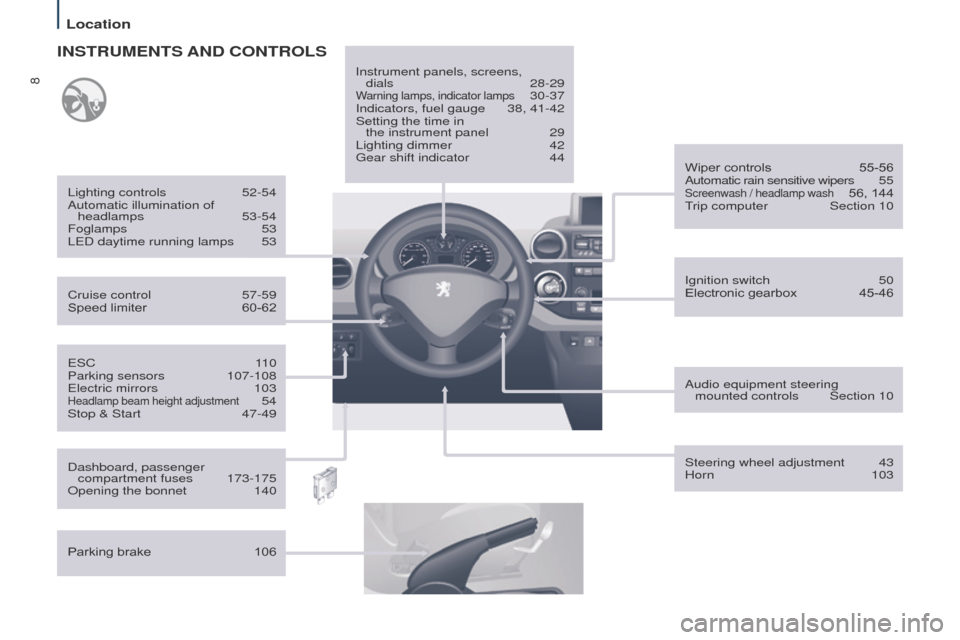
8
Partner_2_VP_en_Chap01_vue-ensemble_ed02-2014
eSC 110
Parking sensors 107-108e
lectric mirrors
103Headlamp beam height adjustment 54
Stop & Start
47-49
Cruise control
57-59
Speed limiter
60-62
Lighting controls
52-54
Automatic illumination of headlamps
53-54
Foglamps
53
L
e
D daytime running lamps
53
INSTRUMENTS AND CONTROLS
Dashboard, passenger
compartment fuses 173-175
Opening the bonnet
140
Parking brake
106 Instrument panels, screens,
dials 28-29
Warning lamps, indicator lamps 30-37
Indicators, fuel gauge
38, 41-42
Setting the time in
the instrument panel
29
Lighting dimmer
42g
ear shift indicator
44
Ignition switch
50
Electronic gearbox
45-46
Wiper controls
55-56
Automatic rain sensitive wipers
5
5
Screenwash / headlamp wash 56, 144trip computer
Section 10
Audio equipment steering mounted controls
Section 10
Steering wheel adjustment
43
Horn
103
Location
Page 12 of 276
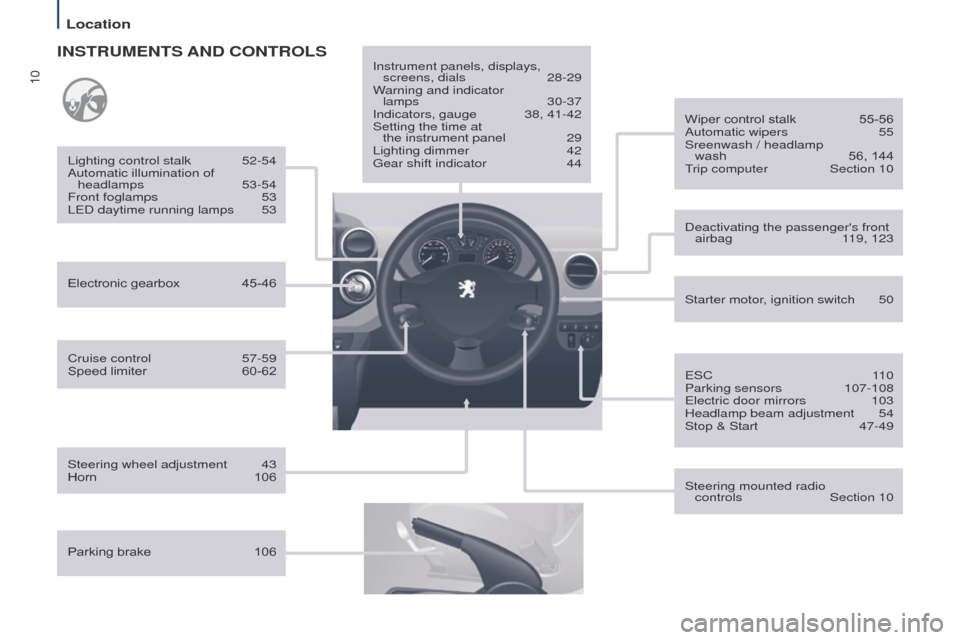
10
Partner_2_VP_en_Chap01_vue-ensemble_ed02-2014
Cruise control 57-59
Speed limiter 60-62
Lighting control stalk
52-54
Automatic illumination of headlamps
53-54
Front foglamps
53
L
e D daytime running lamps
53
INSTRUMENTS AND CONTROLS
Parking brake 106Instrument panels, displays,
screens, dials
28-29
W
arning and indicator
lamps
30-37
Indicators, gauge
38, 41-42
Setting the time at
the instrument panel
29
Lighting dimmer
42g
ear shift indicator
44
Steering wheel adjustment
43
Horn
106 Starter motor
, ignition switch
50
Wiper control stalk
55-56
Automatic wipers
55
Sreenwash / headlamp
wash
56, 144trip computer
Section 10
Steering mounted radio
controls
Section 10
Deactivating the passenger's front
airbag
1
19, 123
e
SC
1
10
Parking sensors
107-108e
lectric door mirrors
103
Headlamp beam adjustment
54
Stop & Start
47-49
Electronic gearbox
45-46
Location
Page 15 of 276
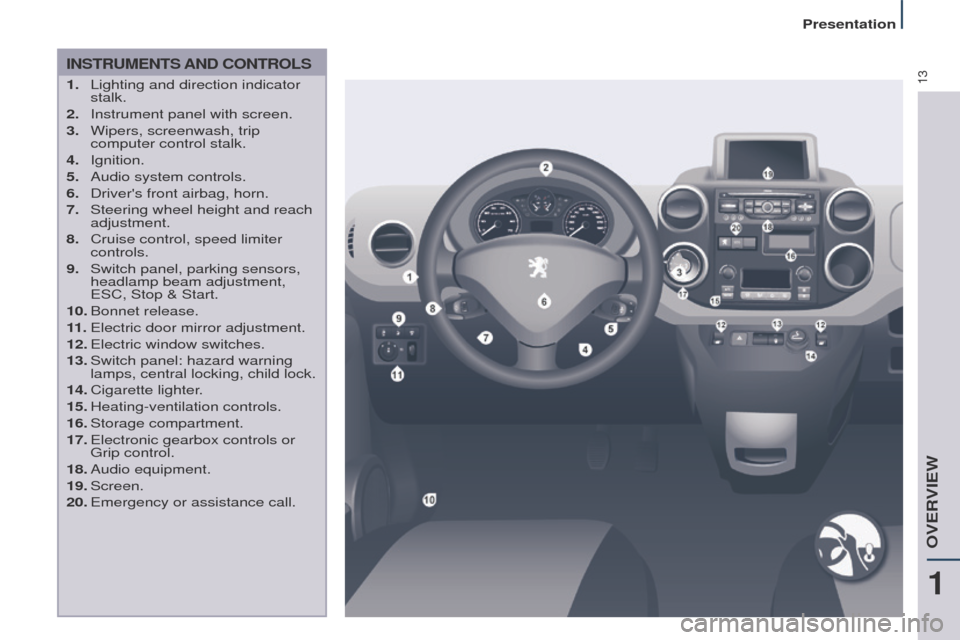
13
Partner_2_VP_en_Chap01_vue-ensemble_ed02-2014
INSTRUMENTS AND CONTROLS
1. Lighting and direction indicator
stalk.
2.
Instrument panel with screen.
3.
Wipers, screenwash, trip
computer control stalk.
4.
Ignition.
5.
Audio system controls.
6.
Driver's front airbag, horn.
7.
Steering wheel height and reach
adjustment.
8.
Cruise control, speed limiter
controls.
9.
Switch panel, parking sensors,
headlamp beam adjustment,
e
SC, Stop & Start.
10.
Bonnet
release.
11 .
e lectric door mirror adjustment.
12.
e lectric window switches.
13.
Switch panel: hazard warning
lamps, central locking, child lock.
14.
Cigarette
lighter.
15.
Heating-ventilation
controls.
16.
Storage
compartment.
17.
e lectronic gearbox controls or
g
rip control.
18.
Audio
equipment.
19.
Screen.
20.
e mergency or assistance call.
1
OVeRVIeW
Presentation
Page 16 of 276
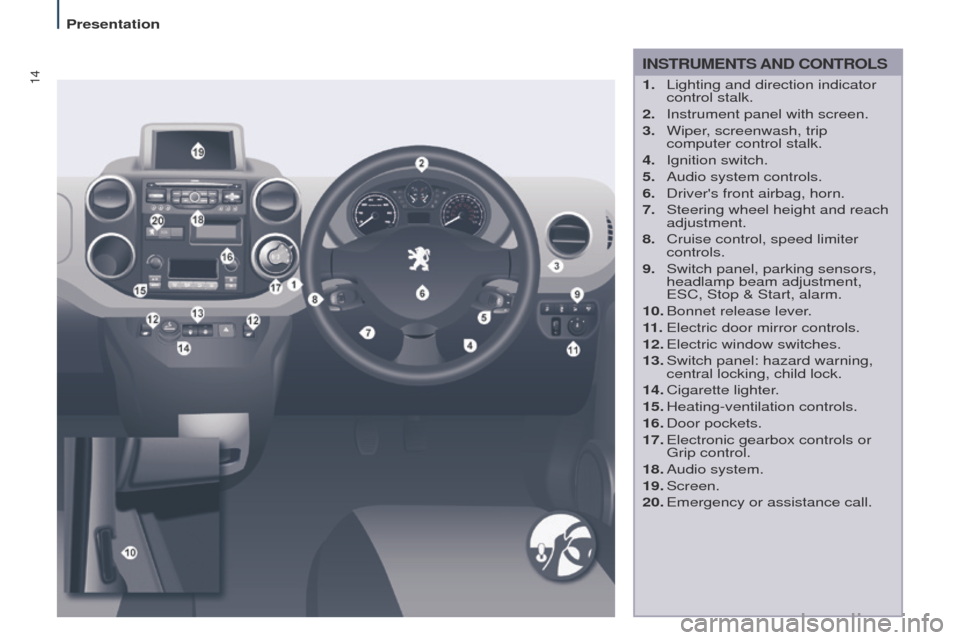
14
Partner_2_VP_en_Chap01_vue-ensemble_ed02-2014
INSTRUMENTS AND CONTROLS
1. Lighting and direction indicator
control stalk.
2.
Instrument panel with screen.
3.
Wiper
, screenwash, trip
computer control stalk.
4.
Ignition switch.
5.
Audio system controls.
6.
Driver's front airbag, horn.
7.
Steering wheel height and reach
adjustment.
8.
Cruise control, speed limiter
controls.
9.
Switch panel, parking sensors,
headlamp beam adjustment,
e
SC, Stop & Start, alarm.
10.
Bonnet release lever
.
11 .
e lectric door mirror controls.
12.
e lectric window switches.
13.
Switch panel: hazard warning,
central locking, child lock.
14.
Cigarette
lighter.
15.
Heating-ventilation
controls.
16.
Door
pockets.
17.
e lectronic gearbox controls or
g
rip control.
18.
Audio
system.
19.
Screen.
20.
e mergency or assistance call.
Presentation
Page 35 of 276
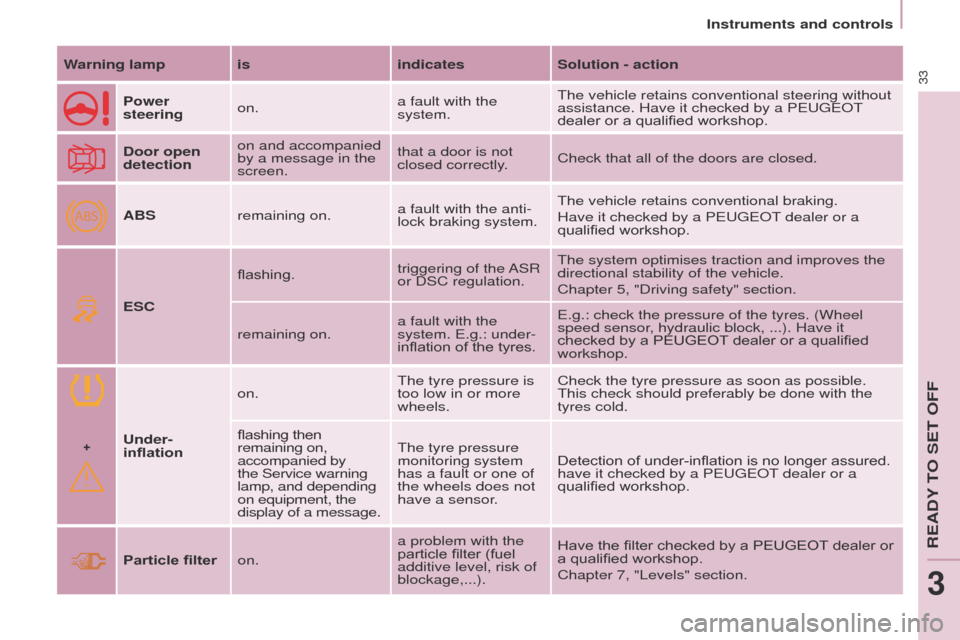
+
ABS
33
Partner_2_VP_en_Chap03_Pret-a-partir_ed02-2014
Warning lamp isindicatesSolution - action
Power
steering on. a fault with the
system.
t
he vehicle retains conventional steering without
assistance. Have it checked by a P
euge O t
dealer or a qualified workshop.
Door open
detection on and accompanied
by a message in the
screen. that a door is not
closed correctly
.Check that all of the doors are closed.
ABS remaining on. a fault with the anti-
lock braking system.
t
he vehicle retains conventional braking.
Have it checked by a P
euge O t
dealer or a
qualified workshop.
ESC flashing.
triggering of the
ASR
or DSC regulation.
t
he system optimises traction and improves the
directional stability of the vehicle.
Chapter 5, "Driving safety" section.
remaining on. a fault with the
system.
e .g.: under-
inflation of the tyres.
e
.g.: check the pressure of the tyres. (Wheel
speed sensor, hydraulic block, ...). Have it
checked by a PEUGEOT dealer or a qualified
workshop.
Under-
inflation on.
t
he tyre pressure is
too low in or more
wheels. Check the tyre pressure as soon as possible.
t
his check should preferably be done with the
tyres cold.
flashing then
remaining on,
accompanied by
the Service warning
lamp, and depending
on equipment, the
display of a message.
t
he tyre pressure
monitoring system
has a fault or one of
the wheels does not
have a sensor. Detection of under-inflation is no longer assured.
have it checked by a P
euge O t
dealer or a
qualified workshop.
Particle filter on. a problem with the
particle filter (fuel
additive level, risk of
blockage,...).Have the filter checked by a PEUGEOT
dealer or
a qualified workshop.
Chapter 7, "Levels" section.
Instruments and controls
READY TO SET OFF
3
Page 41 of 276
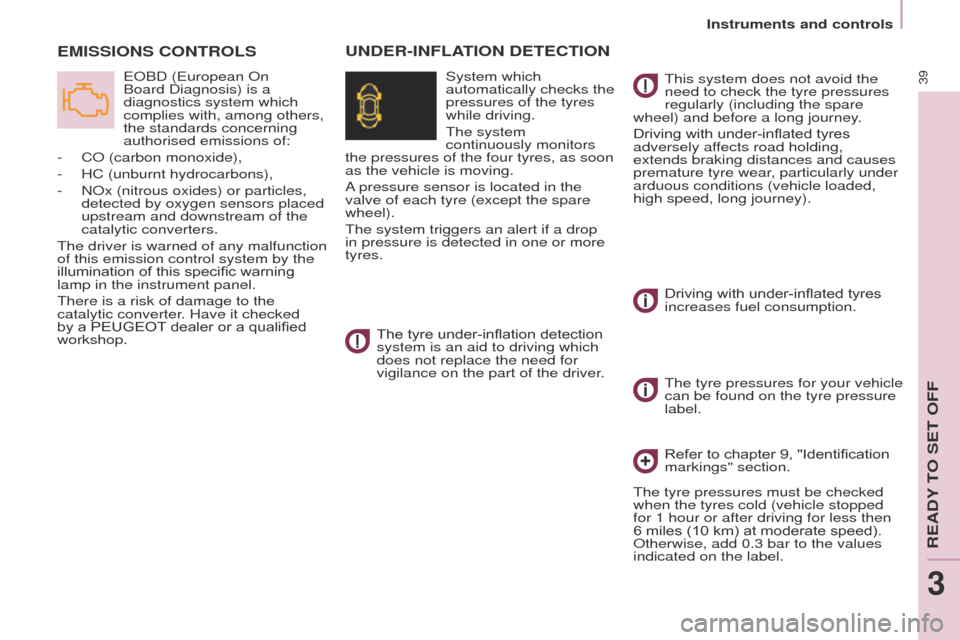
39
Partner_2_VP_en_Chap03_Pret-a-partir_ed02-2014
EMISSIONS CONTROLS
eOBD (european On
Board Diagnosis) is a
diagnostics system which
complies with, among others,
the standards concerning
authorised emissions of:
-
CO (carbon monoxide),
-
HC (unburnt hydrocarbons),
-
NOx (nitrous oxides) or particles,
detected by oxygen sensors placed
upstream and downstream of the
catalytic converters.
t
he driver is warned of any malfunction
of this emission control system by the
illumination of this specific warning
lamp in the instrument panel.
t
here is a risk of damage to the
catalytic converter. Have it checked
by a PEUGEOT dealer or a qualified
workshop.
UNDER-INFLATION DETECTION
System which
automatically checks the
pressures of the tyres
while driving.
t
he system
continuously monitors
the pressures of the four tyres, as soon
as the vehicle is moving.
A pressure sensor is located in the
valve of each tyre (except the spare
wheel).
t
he system triggers an alert if a drop
in pressure is detected in one or more
tyres.
The tyre under-inflation detection
system is an aid to driving which
does not replace the need for
vigilance on the part of the driver
.t his system does not avoid the
need to check the tyre pressures
regularly (including the spare
wheel) and before a long journey.
Driving with under-inflated tyres
adversely affects road holding,
extends braking distances and causes
premature tyre wear, particularly under
arduous conditions (vehicle loaded,
high speed, long journey).
Driving with under-inflated tyres
increases fuel consumption.
t
he tyre pressures for your vehicle
can be found on the tyre pressure
label.
Refer to chapter 9, "Identification
markings" section.
t
he tyre pressures must be checked
when the tyres cold (vehicle stopped
for 1 hour or after driving for less then
6 miles (10 km) at moderate speed).
Otherwise, add 0.3 bar to the values
indicated on the label.
Instruments and controls
ReADY tO Set OFF
3
Page 42 of 276
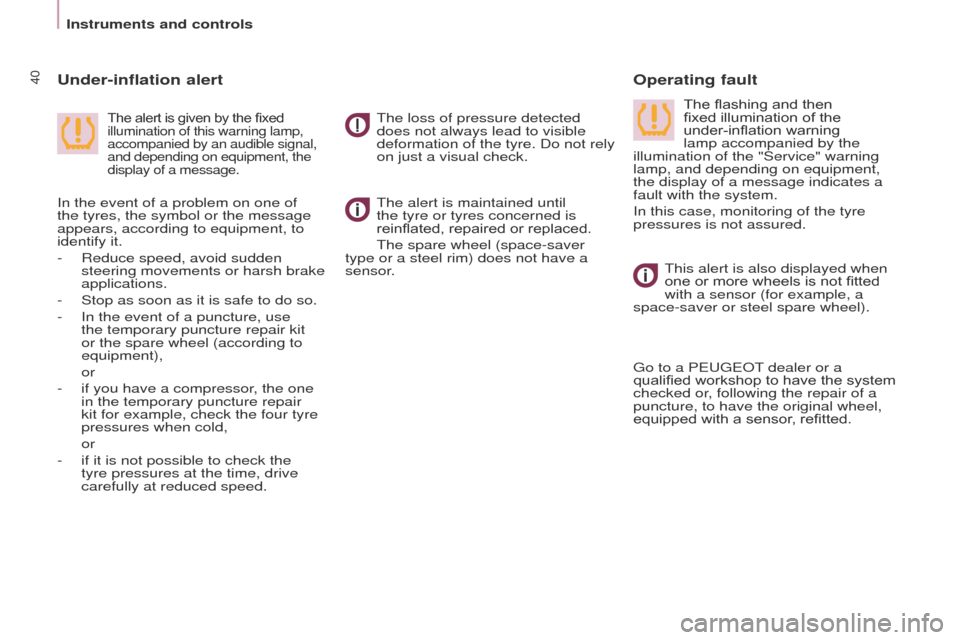
40
Partner_2_VP_en_Chap03_Pret-a-partir_ed02-2014
the alert is maintained until
the tyre or tyres concerned is
reinflated, repaired or replaced.
t
he spare wheel (space-saver
type or a steel rim) does not have a
sensor.
Operating fault
Under-inflation alert
the loss of pressure detected
does not always lead to visible
deformation of the tyre. Do not rely
on just a visual check.The alert is given by the fixed
illumination of this warning lamp,
accompanied by an audible signal,
and depending on equipment, the
display of a message.The flashing and then
fixed illumination of the
under-inflation warning
lamp accompanied by the
illumination of the "Service" warning
lamp, and depending on equipment,
the display of a message indicates a
fault with the system.
In this case, monitoring of the tyre
pressures is not assured.
In the event of a problem on one of
the tyres, the symbol or the message
appears, according to equipment, to
identify it.
-
Reduce speed, avoid sudden
steering movements or harsh brake
applications.
-
Stop as soon as it is safe to do so.
-
In the event of a puncture, use
the temporary puncture repair kit
or the spare wheel (according to
equipment),
or
-
if you have a compressor
, the one
in the temporary puncture repair
kit for example, check the four tyre
pressures when cold,
or
-
if it is not possible to check the
tyre pressures at the time, drive
carefully at reduced speed.
t
his alert is also displayed when
one or more wheels is not fitted
with a sensor (for example, a
space-saver or steel spare wheel).
g
o to a P euge O t
dealer or a
qualified workshop
to have the system
checked or, following the repair of a
puncture, to have the original wheel,
equipped with a sensor, refitted.
Instruments and controls
Page 55 of 276
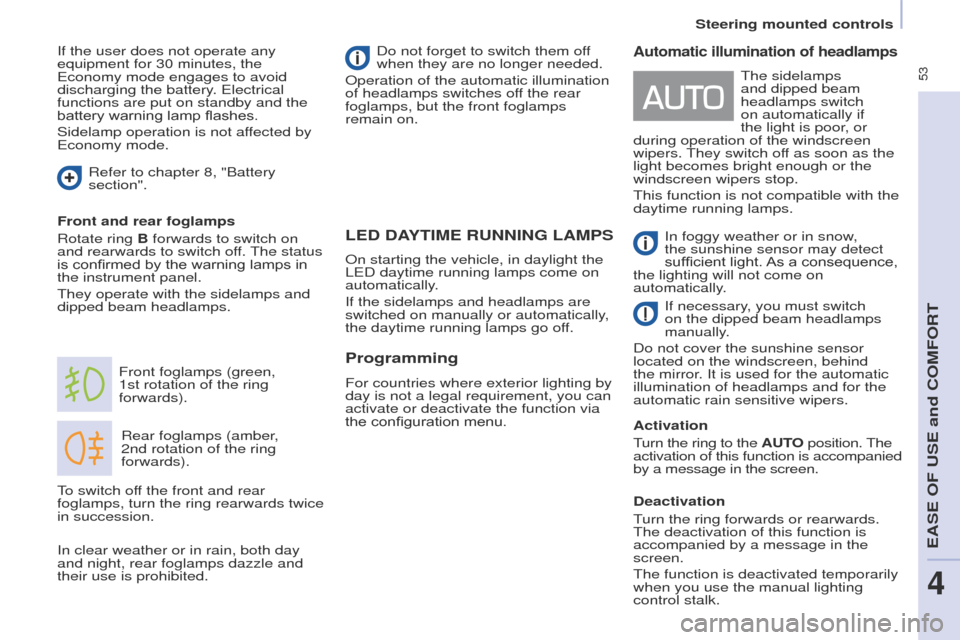
53
Partner_2_VP_en_Chap04_ergonomie_ed02-2014
LED DAYTIME RUNNING LAMPS
Rear foglamps (amber,
2nd rotation of the ring
forwards).
Front foglamps (green,
1st
rotation of the ring
forwards).
Front and rear foglamps
Rotate ring B forwards to switch on
and rearwards to switch off.
t
he status
is confirmed by the warning lamps in
the instrument panel.
t
hey operate with the sidelamps and
dipped beam headlamps. Do not forget to switch them off
when they are no longer needed.
Operation of the automatic illumination
of headlamps switches off the rear
foglamps, but the front foglamps
remain on.
to switch of
f the front and rear
foglamps, turn the ring rearwards twice
in succession.
Automatic illumination of headlamps
In foggy weather or in snow,
the sunshine sensor may detect
sufficient light. As a consequence,
the lighting will not come on
automatically.
If necessary, you must switch
on the dipped beam headlamps
manually.
Do not cover the sunshine sensor
located on the windscreen, behind
the mirror. It is used for the automatic
illumination of headlamps and for the
automatic rain sensitive wipers.
Activation
turn the ring to the
AUTO position. t he
activation of this function is accompanied
by a message in the screen.
Deactivation
turn the ring forwards or rearwards. t
he deactivation of this function is
accompanied by a message in the
screen.
t
he function is deactivated temporarily
when you use the manual lighting
control stalk.
t
he sidelamps
and dipped beam
headlamps switch
on automatically if
the light is poor, or
during operation of the windscreen
wipers.
t
hey switch off as soon as the
light becomes bright enough or the
windscreen wipers stop.
t
his function is not compatible with the
daytime running lamps.
On starting the vehicle, in daylight the
L
e
D daytime running lamps come on
automatically.
If the sidelamps and headlamps are
switched on manually or automatically,
the daytime running lamps go off.
Programming
For countries where exterior lighting by
day is not a legal requirement, you can
activate or deactivate the function via
the configuration menu.
If the user does not operate any
equipment for 30 minutes, the
e
conomy mode engages to avoid
discharging the battery.
e
lectrical
functions are put on standby and the
battery warning lamp flashes.
Sidelamp operation is not affected by
e
conomy mode.
In clear weather or in rain, both day
and night, rear foglamps dazzle and
their use is prohibited. Refer to chapter 8, "Battery
section".
Steering mounted controls
eASe OF uSe and COMFORt
4
Page 56 of 276
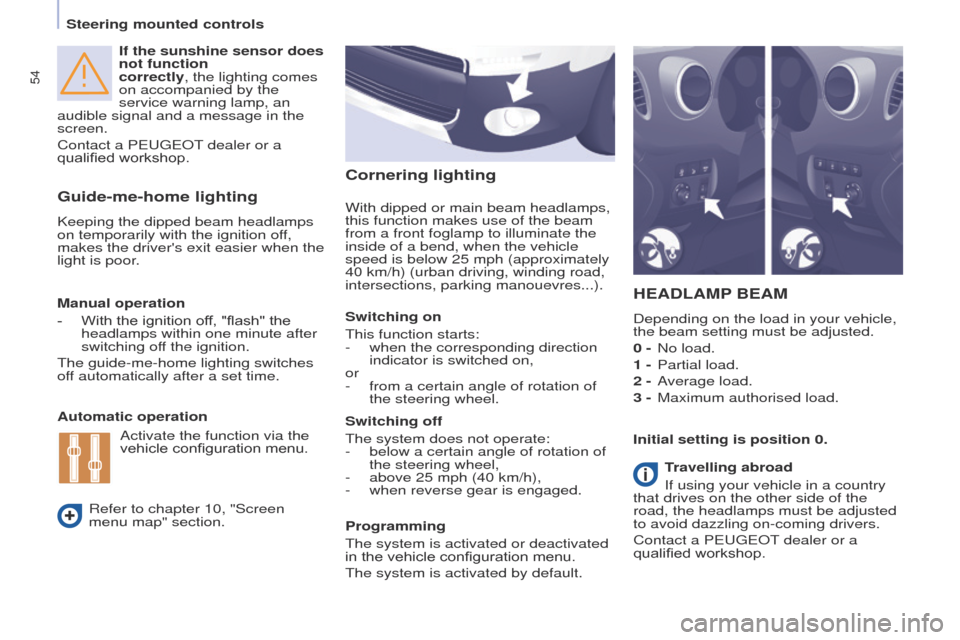
54
Partner_2_VP_en_Chap04_ergonomie_ed02-2014
If the sunshine sensor does
not function
correctly, the lighting comes
on accompanied by the
service warning lamp, an
audible signal and a message in the
screen.
Contact a P
euge O t
dealer or a
qualified workshop.
Guide-me-home lighting
Keeping the dipped beam headlamps
on temporarily with the ignition off,
makes the driver's exit easier when the
light is poor.
HEADLAMP BEAM
Depending on the load in your vehicle,
the beam setting must be adjusted.
0 -
No load.
1 -
Partial load.
2 -
A
verage load.
3 -
Maximum authorised load.
Manual operation
-
With the ignition of
f, "flash" the
headlamps within one minute after
switching off the ignition.
t
he guide-me-home lighting switches
off automatically after a set time.
Automatic operation
Refer to chapter 10, "Screen
menu map" section. Initial setting is position 0.
Activate the function via the
vehicle configuration menu.
Programming
t
he system is activated or deactivated
in the vehicle configuration menu.
t
he system is activated by default.
Switching off
t
he system does not operate:
-
below a certain angle of rotation of
the steering wheel,
-
above 25 mph (40 km/h),
-
when reverse gear is engaged.
Switching on
t
his function starts:
-
when the corresponding direction
indicator is switched on,
or
-
from a certain angle of rotation of
the steering wheel.
With dipped or main beam headlamps,
this function makes use of the beam
from a front foglamp to illu
minate the
inside of a bend, when the vehicle
speed is below 25 mph (approximately
40 km/h) (urban driving, winding road,
intersections, parking manouevres...).
Cornering lighting
Travelling abroad
If using your vehicle in a country
that drives on the other side of the
road, the headlamps must be adjusted
to avoid dazzling on-coming drivers.
Contact a P
euge O t
dealer or a
qualified workshop.
Steering mounted controls